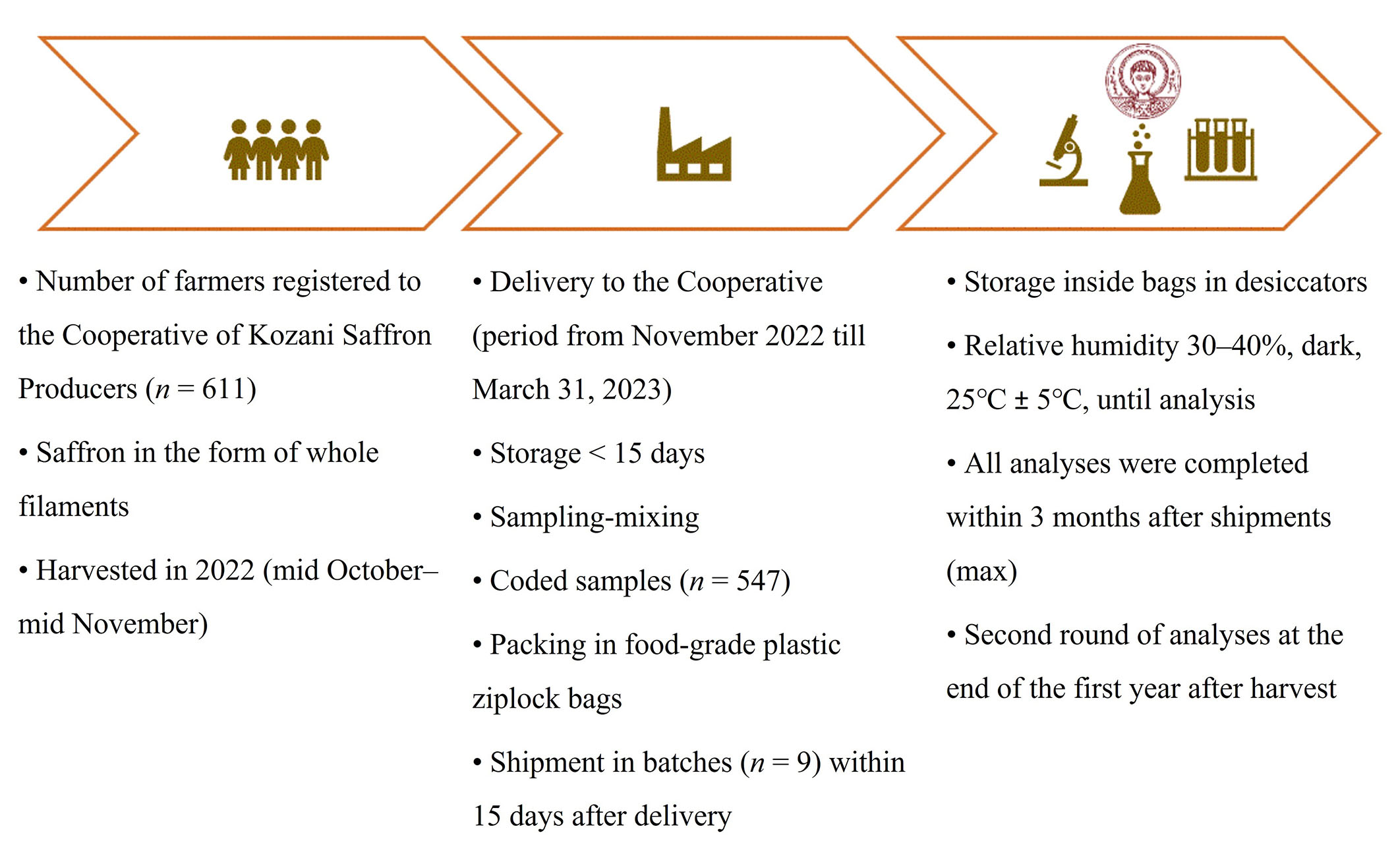Abstract
Aim:
Saffron, a precious spice deriving from the emblematic Crocus sativus L. cultivation, is a traditional product with high socio-economic and cultural value in Greece, especially in the region of Western Macedonia where the Protected Designation of Origin (PDO) Krokos Kozanis thrives. Since 1981, its international trade has relied on the International Standard Organization (ISO) 3632 standard specifications for quality classification. Currently, the Codex Alimentarius Committee on spices and culinary herbs is developing a “Codex standard for dried floral parts—Saffron”, which introduces a new “extra” quality class on top of the existing ones. Efforts are underway to harmonize both standards for the benefit of the interested parties. In this direction, scientific evidence from compositional databases is essential for objective decision-making. This work presents a systematic study of the compositional variability in Greek saffron in terms of coloring, flavor, and aroma strength, according to ISO and Codex standards.
Methods:
Saffron samples (n = 547) were obtained from the registered growers-members of the Cooperative of Kozani Saffron Growers (Kozani, Western Macedonia, Greece, 2022 harvest). The samples were collected under the responsibility of the administration and quality control manager of the Cooperative, sent directly to the laboratory and analyzed according to ISO 3632-2 test methods for moisture, coloring, flavor, and aroma strength. The analytical data were combined with meta-data about individual member production, processing practices, etc.
Results:
The captured trends and overall discussion reveal to which extent the Greek PDO Krokos Kozanis can address challenges stemming from the introduction of the “extra” category.
Conclusions:
The results were used to initiate building a compositional database for the PDO Krokos Kozanis. The data should be regularly updated to serve not only the internal quality control management system of the Cooperative but also as reliable documentation for the official controls of the registered product.
Keywords
Saffron integrity, spices, compositional database, Protected Designation of Origin, Krokos Kozanis, quality criteria, International Standard Organization 3632 trade standard, Codex AlimentariusIntroduction
Saffron spice is comprised of the dried stigmas and part of the styles of the flower (Crocus sativus L.). It is the most expensive spice in the world and is traded globally based on specifications of the International Standard Organization (ISO) 3632-1 standard, which are analytically supported by those included in the ISO 3632-2 standard [1, 2]. Recently, the ISO 21983:2019 standard [3] has been also issued to offer guidelines for harmonization in the harvesting and processing stages. Moreover, the Codex Committee on Spices and Culinary Herbs (CCSCH) of the Codex Alimentarius Commission is in the course of finalizing an international standard that introduces substantial changes in the specifications of traded saffron [4]. Most importantly, except for the commercial categories I, II, and III a superior category, “extra”, is proposed. These changes are expected to influence the ISO 3632-1 standard specifications, which are currently subjected to revision as international bodies seek for harmonization of standards and alignment among commercial categories, worldwide.
Products of geographical origin, in particular, are highly valued among the European Union (EU) consumers and are considered an asset among the EU-exported food products to third countries [5]. The relevant Regulation (EU) No 1151/2012 [6] for geographical indications in the EU protects the intrinsic characteristics of the registered products. Registration is based on both administrative and analytical data. The submitted documentation must contain reliable data on the product integrity that can be used for official controls and can be proved also useful in cases of disputes or fraudulent practices that can jeopardize the efforts of producers and fair trade.
Saffron, is an emblematic product deserving special attention by the EU agricultural and food authorities that support biodiversity and sustainability of traditional cultivations and species in the agri-food sector [7]. The cultivation of the Crocus sativus L. plant is rather limited in the EU member states. Five are the registered saffron Protected Designation of Origins (PDOs), namely Krokos Kozanis (1999), “Azafrán de la Mancha” (2001), “Zafferano dell’ Aquila” (2005), “Zafferano di San Gimignano” (2005), and “Zafferano di Sardegna” (2008) according to the eAmbrosia EU geographical indications register [8]. Among them, the Greek one presents an interesting uniqueness related to the fact that the majority of the farmers, who cultivate the plant, are members of a cooperative that is responsible for the collection of the annual production and after carrying out the necessary quality and safety controls, for storage, packaging, labeling, and commercial transactions. The compulsory scheme enables fair trading practices and sufficient bargaining power between buyer and seller. The net profit from the transactions is shared among the producers. This farm-to-fork enterprise system became a critical factor for the establishment of the Greek saffron repute in the international highly competitive landscape for this spice.
In view of strengthening the positioning of the product worldwide and improving further agricultural and processing practices that influence the quality of the product and its self-life, the present work was carried out in close cooperation with the producers. The work presents the results of a systematic study on the compositional variation in Greek saffron, the major European-origin product. The results refer to a set of 547 samples that represent the total production of every registered grower-member of the Cooperative of Kozani Saffron Producers (Kozani, West Macedonia, Greece) from the 2022 harvest. The samples were collected under the responsibility of the administration and quality control (QC) manager of the Cooperative. The samples were shipped directly to the Laboratory of Food Chemistry and Technology (LFCT) and analyzed according to ISO 3632-2 test methods for total moisture, coloring strength (CS), flavor strength (FS), and aroma strength (AS) in less than 3 months after delivery. Among the three latter attributes, CS is strongly associated with the actual content of pigments; a group of highly water-soluble esters of crocetin (8,8’-diapocarotenedioic acid), collectively known as crocins, being dominant. According to ISO 3632, the AS and FS, which are the other two parameters of economic importance for saffron, are associated with safranal and picrocrocin contents, respectively [9]. It is important to emphasize that these organoleptic properties are assessed objectively with the aid of ultraviolet-visible (UV-Vis) spectrophotometry. Meta-data about production size for each grower, processing practices, and other factors of importance for the cultivation and annual production of saffron in the Kozani region were used to build a comprehensive database for mapping the variation in its quality characteristics. The captured trends and overall discussion reveal to which degree the Greek PDO Krokos Kozanis annual produce fulfills challenges stemming from the upcoming introduction of the “extra” category in the international trade standards repertoire for this most expensive spice.
Materials and methods
Experimental study design
In total, the 547 samples in dried whole filament form (saffron) were obtained directly from the Cooperative of Kozani Saffron Producers (Krokos, Kozani, Western Macedonia, Greece). They were packed in food-grade plastic ziplock bags and shipped in batches (n = 9) to LFCT not later than 15 days after the delivery of each grower’s product to the Cooperative installations within a defined collection period (typically extending from the end of the harvest period until 31 March). The samples were maintained inside the bags, and placed in desiccators so that the relative humidity did not exceed 30–40% in the dark at 25°C ± 5°C, until analysis (Figure 1).
Each sample represented the annual produce of an individual registered member or of a group of 2–3 members, who belong to the same family and share the same installations and practices for processing saffron (cleaning from floral waste, drying, sorting, storage). Therefore, the 547 samples were obtained from all of the 611 registered producers.
Meta-data collection
Other useful information about e.g., the identity code, the type of cultivation (conventional/organic), QC data (moisture content), and date of delivery along with the size of the annual produce per member was kindly provided by the Cooperative at request. Additional meta-data about the location of farms, demographic (gender, age, level of education), processing (drying) practices, and personal observations or views were extracted from the responses of 172 volunteer growers to survey forms that were distributed online or in-hand by the Cooperative administration office. The data were elaborated through Microsoft® Excel 2016 (Microsoft Corporation, Redmond, WA, USA). Meteorological data for the Kozani region were collected from the Hellenic National Meteorological Service (HNMS) [10].
Examination of the major quality characteristics according to ISO 3632-2:2010
Residual moisture and volatile content determination
Residual moisture and volatile content (%, w/w) of saffron samples were determined in duplicate using the gravimetric method recommended in ISO 3632-2:2010 [2]. Briefly, the plant material (2.5 g) was dried till constant weight in an oven set at 103°C ± 2°C for 16 h. The content was calculated by the following equation:
The relative standard deviation (RSD%) of five measurements per sample extract (n = 5) for five samples (n = 5) by the same analyst was calculated to assess the intra-day precision of the method (1.9% to 6.9%).
CS, FS, and AS estimation
Saffron stigmas were ground in a pestle mortar and passed through a sieve of 0.5 mm mesh, following the crushing and sieving method proposed in ISO 3632-2:2010 [2]. Aqueous extracts of ground stigmas were prepared as follows. An amount of 0.1 g stigmas of ground stigmas (±0.001 g) was mixed with deionized water in a 200 mL volumetric flask. Major constituents (crocetin sugar esters and picrocrocin) were extracted by rigorous agitation (1,000 r/min) at ambient temperature (25°C), away from direct sunlight for 1 h. Prior to analysis, an aliquot from the extract was diluted (1:10, v/v) with deionized water. For each sample studied, duplicate extracts were prepared, and each one was diluted twice. The UV-Vis spectra of water extracts were recorded in the region 200–600 nm using a 1 cm pathway quartz cell in a Shimadzu UV 1601 (Kyoto, Japan) spectrophotometer. The data were processed with the aid of UVProbe 2.61 (Shimadzu Co., Kyoto, Japan) software facilities. CS, FS, and AS of the samples, expressed as
Where D represents absorbance value; m represents the mass of the test portion (g); λmax = 440 nm (for crocetin sugar esters); λmax = 257 nm (for picrocrocin); and λmax = 330 nm (for safranal). The reported values are the average values of four measurements per sample, all performed by the same analyst.
Statistical analysis
Data analysis [descriptive statistics, one-way analysis of variance (ANOVA)] was carried out using the Microsoft® Excel 2016. SIMCA® 17.02 (Umetrics, Sweden) was used for the multivariate analysis of the spectrophotometric data through descriptive statistics and principal component analysis (PCA).
Results
Data descriptors
Geographical area of the cultivation
According to the Cooperative records (personal communication) most saffron farms are located in a region around the village Krokos that extends to the west and along the lake Polifytos (Figure S1). It is worth noting that only a few of the farms are located more than 30 km away from this focal point, where all the annual produce is collected and further processed to form Krokos Kozanis (e.g., 40°04’13”N, 21°51’48”E to 40°15’3”N, 21°48’4”E) (Figure S1).
Climate parameters
Meteorological data that were extracted from the records of the HNMS [10] show the variation in monthly mean, average max, and average min temperatures (°C), and precipitation volumes (mm) throughout the period from December 2021 to December 2022 (Table 1). The sequence of the growth stages of Crocus sativus plant is given in Figure S2 [11]. Moreover, statistical meteorological data for the period 1955–2022 (from the same source) are presented in supplementary Figures S3 and S4 to assist discussion.
Meteorological data for Kozani station of HNMS (longitude 21.83, latitude 40.2) for the period December 2021 to December 2022 [10]
| Month/Year | Average temperature (°C) | Precipitation height (mm) | ||
|---|---|---|---|---|
| Mean | Maximum | Minimum | ||
| December/2021 | 4.4 | 8.7 | 0.8 | 61 |
| January/2022 | 2.3 | 7.5 | –1.8 | 75 |
| February/2022 | 5.1 | 10.3 | 0.1 | 57 |
| March/2022 | 4.5 | 9.4 | –1 | 53 |
| April/2022 | 12.4 | 18.3 | 5.5 | 26 |
| May/2022 | 18.7 | 24.8 | 11.5 | 29 |
| June/2022 | 23.4 | 29.4 | 17.2 | 77 |
| July/2022 | 25.0 | 30.9 | 18.5 | 44 |
| August/2022 | 23.2 | 30.0 | 18.4 | 73 |
| September/2022 | 19.6 | 26.1 | 14 | 14 |
| October/2022 | 15.1 | 21.6 | 9.9 | 32 |
| November/2022 | 10.2 | 15.2 | 6.5 | 63 |
| December/2022 | 7.0 | 11.6 | 3.6 | 34 |
In the period from December 2021 to March 2022, the total precipitation volume was almost 50% higher than the average value of respective data recorded for the period 1955–2021 (Figure S3). In contrast, April and May 2022 were far much drier months; there was a nearly 50% reduced precipitation compared to the reported 65-year average and the trend reversed the summer months (June−August), which were exceptionally wet. September 2022 was unusually dry. This period is critical for boosting the flowering season. October with 32 mm and November with 63 mm were not adequate to result in an appreciable yield per acre (Cooperative administration, personal communication). As far as mean temperature is concerned (Figure S4), there was an ascending trend of more than 1°C in the period October to December 2022, compared to the 65-year average recorded across the timeline. It is stressed that both May and October 2022 were quite hot and dry compared to the historical data signifying the need for further research about the changing climate effect on the local saffron production and the quality characteristics of Krokos Kozanis.
Type of farming
Since the beginning of the century, according to the Cooperative records, the majority of farmers are registered or in the process of achieving organic farming certification.
Scale of individual production
After drying and home-processing by each registered member for about 1–2 months, pure saffron in the form of dried filaments is produced. In the 2022 saffron harvest, the majority of growers delivered to the Cooperative installations approximately 0.01 kg to 2 kg (see Figure 2) indicating that the typical scale of individual production is very small. Nevertheless, about 5% of the growers managed to deliver more than 5 kg of saffron. The distributed sites of home production entail diverse practices (e.g., cleaning and drying conditions, sorting of stigmas, number of persons involved) within this small area of cultivation. However, the product of each grower that is delivered to the Cooperative is further processed (sorting, storage, packaging) and finally, the annual produce is homogenized and standardized as Krokos Kozanis. The particular system describes the conditions under which saffron has been domestically produced in the area around the village of Krokos for more than 50 years.
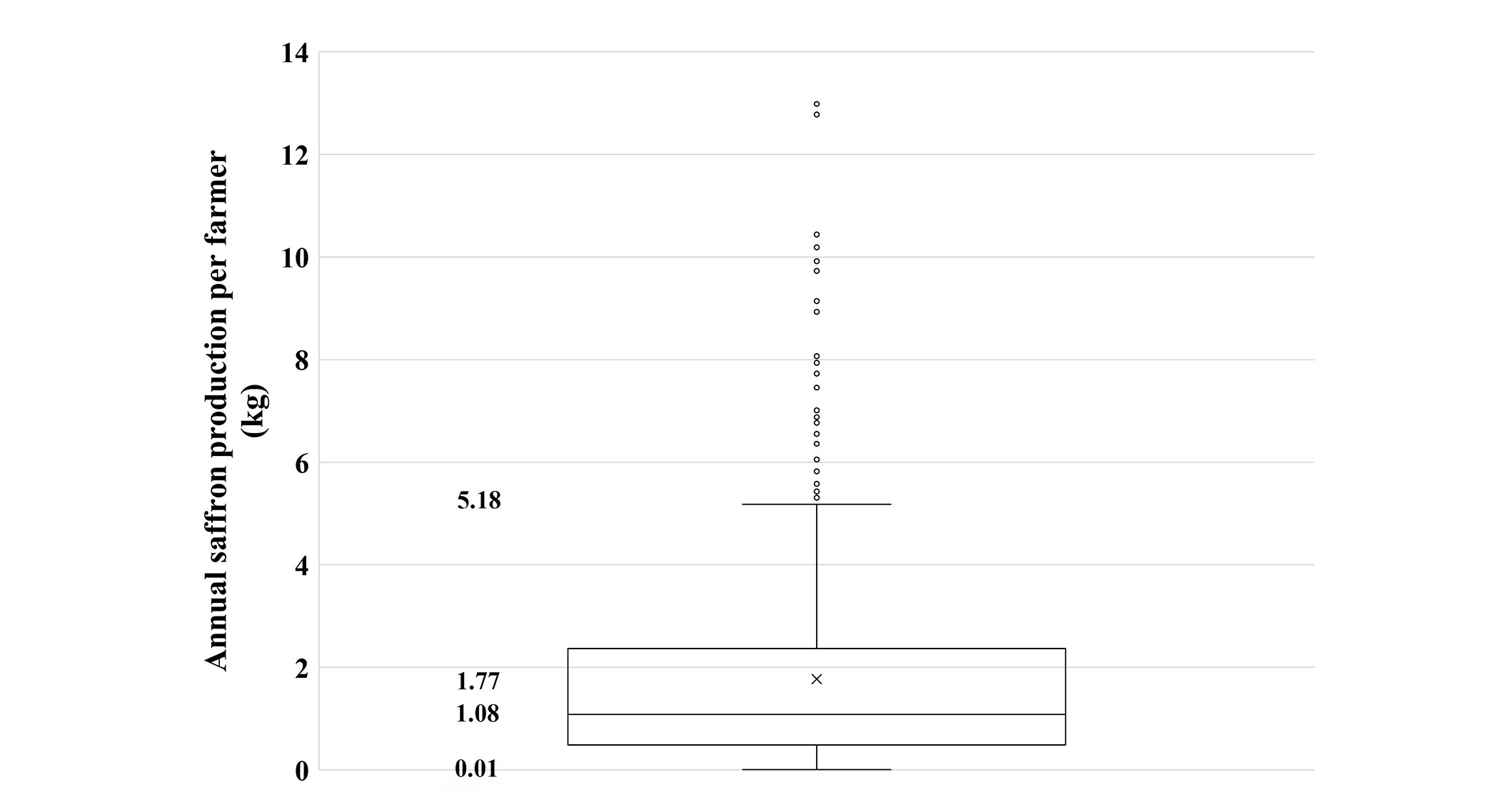
Box-plot showing the variation in the size of each grower’s annual produce during the 2022 harvest period in the Kozani region, among 611 registered members of the Cooperative. Mean (line) and median (symbol) values are highlighted in the box
Demographic profile of saffron growers
Based on the responses of 172 individual growers (almost 1 out of 3 registered members of the Cooperative) about the location of their farms, the geographical distribution of the respondents covered the whole saffron cultivation area (see Figure S1). Only 11% of those saffron growers are under 35 years old; these young farmers are balanced in gender and with a very high level of literacy (technical schools, university degree, Figure S5A) but also with experience in saffron production, due to their enrolment in past family activities. Their annual produce ranged from 220 g to 1.6 kg with only one of them reaching 3 kg of dry saffron. As far as concerns the rest of the older growers, half of them have not completed high school (secondary education) but there is still a significant proportion (22%) that holds a higher-level diploma (e.g., vocational or academic degree). Approximately 75% of the growers are women (Figure S5B), a figure that deserves special attention considering that saffron production represents mainly a secondary agricultural activity in the local community in Kozani. The available data imply that for 2 out of 3 respondents, saffron cultivation offers a complementary income to their family. The registered growers are adequately educated (Figure S5C and D) for adopting good agricultural and hygiene practices. It is not clear whether the motivation is only economically driven or/and emotionally linked with the local tradition. It is worth noting that a small proportion of the > 35-year-old growers (almost 14%) seem to have been engaged in the cultivation within the last 5 years after being trained by other family members. Over 75% of the respondents are sole members, representing their families in the Cooperative. Given that almost half of the registered members are small-scale producers (e.g., < 1 kg dry saffron on an annual basis, see Figure 2), they claimed much lower demand for external workers in comparison to those who produce up to 5 kg or even 10 kg of saffron. As expected, there is a higher demand during the short, labor-intensive period of harvesting flowers than in the later stages of domestic production [9].
Residual moisture and volatile content data
In the region of Kozani, saffron collection period during which each registered grower may deliver their product to the Cooperative installations lasts about 4 months (until the 31st of March). In the course of the internal QC system of the Cooperative, each product presented in dried, whole filament form is sampled and rapidly inspected (a) with the use of infrared moisture balance, to assess whether its residual moisture falls below an internal maximum limit (< 10%, w/w); and (b) visually, to track and remove residual extraneous matter (inorganic or organic) or floral waste (e.g., pollen). Each delivered quantity is recorded facilitating, thus, the transparency of the supply chain from producers to the Cooperative.
In this study, the standard ISO 3632-2 method was used to assess the moisture and volatile content (%) of 547 test samples. The results verified that almost 90% of the samples that were analysed in a period between 1 month and 3 months after processing had the moisture and volatile content < 10%, in line with the internal specification of the Cooperative’s QC system. The frequency distribution plot, shown in Figure 3, indicates that the majority of the moisture values fluctuated asymmetrically in the range of 6.5−9.5%, with a positive skewness, towards the lower moisture and volatile content values.
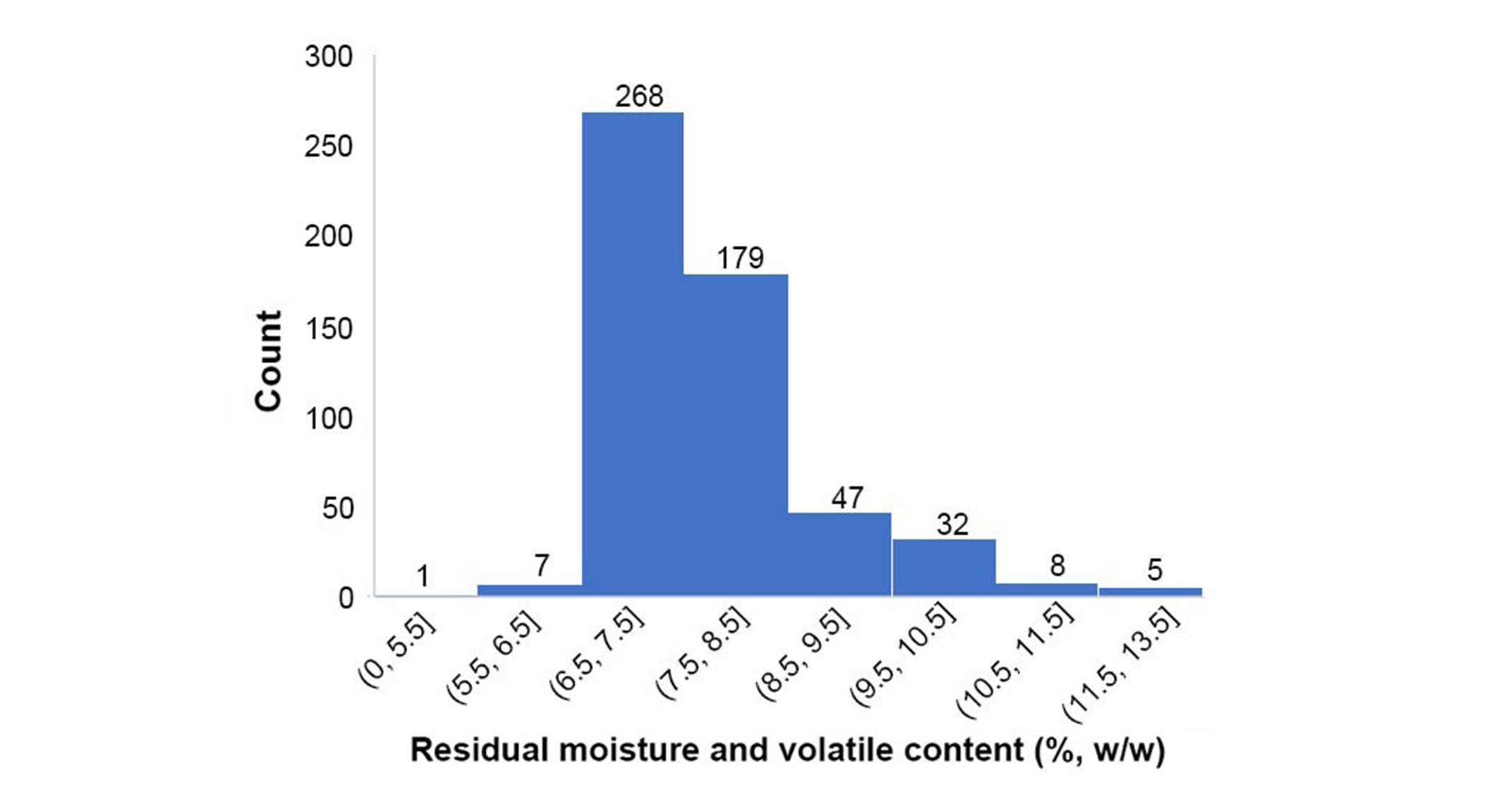
Frequency distribution histogram of residual moisture and volatile content values for saffron samples (n = 547) representing each grower’s annual produce during the 2022 harvest period in Kozani region
Among the remaining 10% of the test samples, a few outliers were detected falling below 5.5% (w/w) and quite a larger number surpassed the moisture and volatile content value of 9.5% (w/w). The latter observation could signify individual products that are more vulnerable to spoilage or quality deterioration if stored improperly in the course of processing (e.g., water activity ≥ 0.53 or relative humidity > 23%) [9]. It is worth noting that only a few samples did not comply with the ISO 3632-1 specification for the maximum allowed residual moisture content (i.e., 12%, w/w). They represent, in total, about 8 kg of saffron that were delivered to the Cooperative shortly after drying and cleaning. The relative amount of this type of sample is minor compared to the annual production in the Kozani region during 2022 (1,261 kg). Even so, it is emphasized that the specific internal QC tool of the Cooperative needs to be regularly validated against reference methods for moisture determination. A proper validation plan will help to safeguard the desirable high quality of the PDO Krokos Kozanis.
Building the compositional database for the main quality characteristics of Krokos Kozanis according to ISO 3632-1
Metrological issues
The UV-Vis spectral intensities of saffron aqueous extracts at 440 nm, 257 nm, and 330 nm are of major importance for the classification of traded saffron into quality categories. They are used to estimate the ISO-based main quality characteristics of the spice, that is, CS, FS, and AS, respectively. The results are expressed only on a dry basis that presumes the determination of residual moisture content (see Materials and methods). In practice, absorption at 440 nm has the greatest impact on economic transactions because, when a sample fulfills the requirements of any category regarding CS (
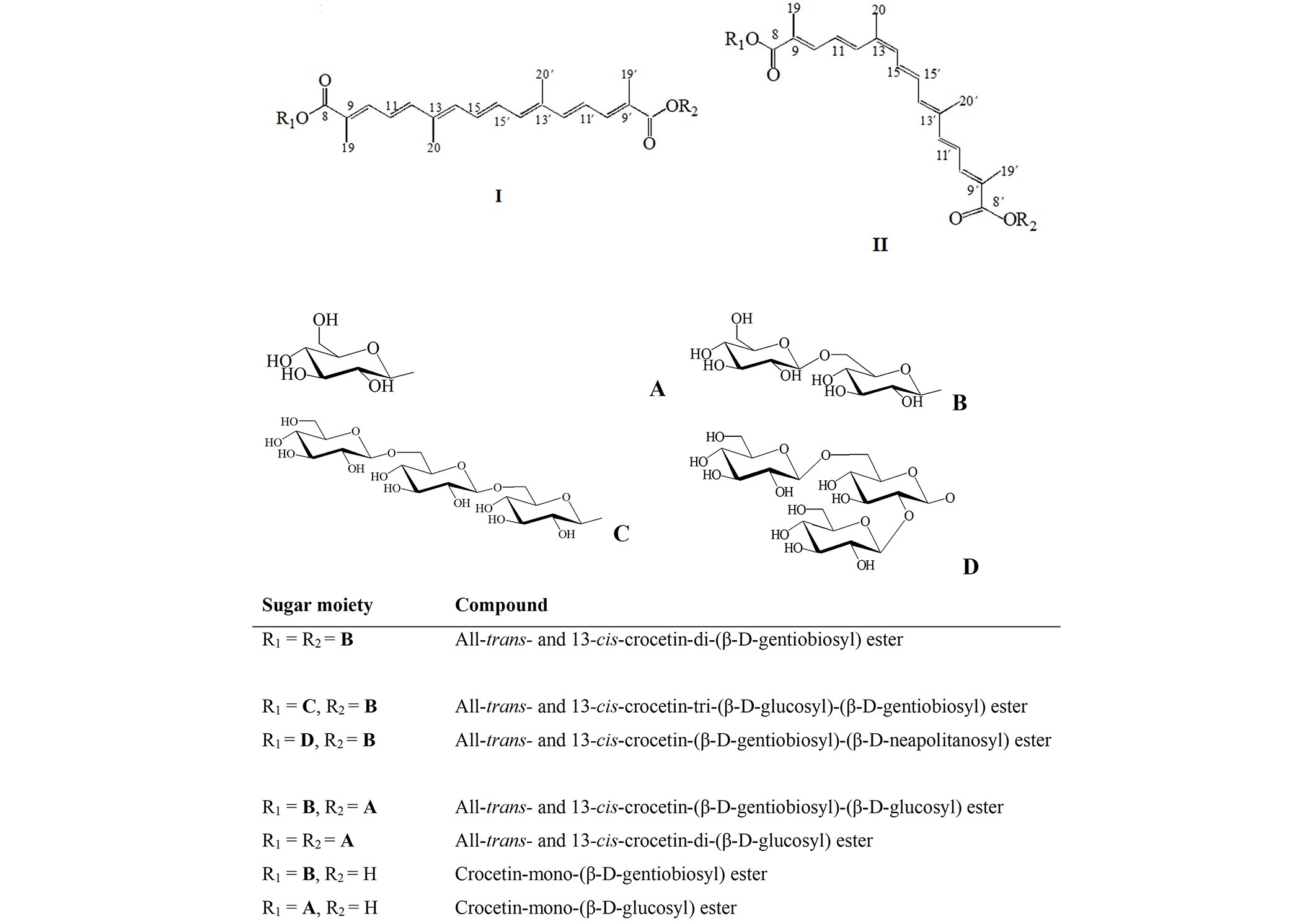
Chemical structures and nomenclature of major all-trans and 13-cis-isomers of crocetin esters (I, II) with sugars (A–D) that can be found in saffron extracts with polar solvents
The analytical protocol that is described in the ISO 3632-2:2010 standard refers to ISO 3632-1:2011 for minimum limits and definitions of saffron quality categories. However, there are no accuracy or maximum tolerance data stemming from the application of the protocols. In this study, the RSD% of the spectral intensity of four working solutions (2 working solutions per replicate extract) per tested saffron sample at each wavelength was plotted to assess their range characteristics. As shown in Figure 5, these values were quite low for the majority of the samples tested, ranging from ±0.1% to ±4.7% when absorbance was expressed as
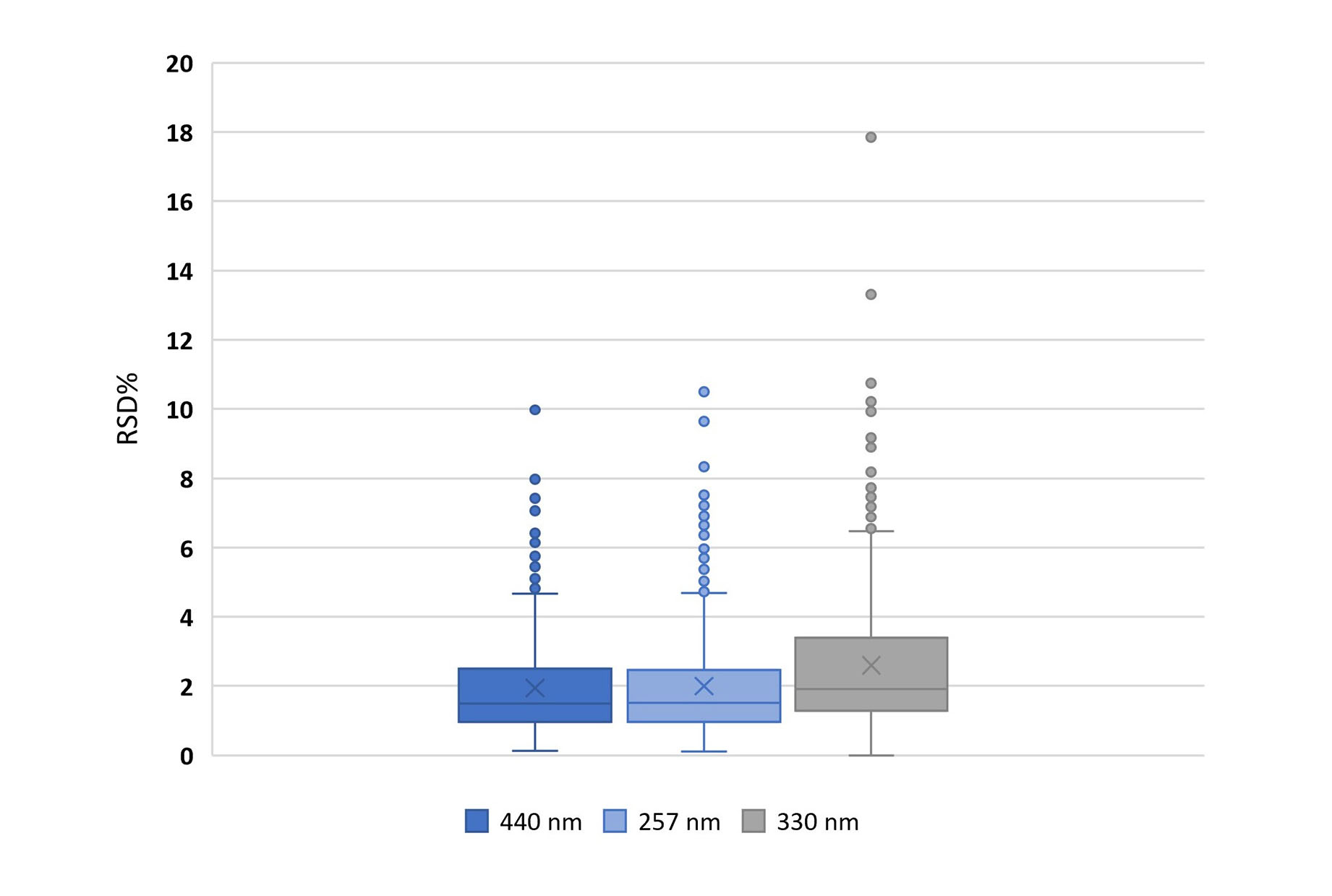
Box-plots showing the variation in RSD% values upon measurement of CS, FS, and AS values (E1% at 440 nm, 257 nm, and 330 nm, respectively) of every individual grower’s annual produce (n = 547) during the 2022 harvest period in the Kozani region. Mean (line) and median (symbol ×) values are highlighted inside each box
Apart from the variation in measurements, it is necessary to emphasize here other two issues of methodological concern. According to ISO 3632, the UV-Vis extinction coefficient values at 257 nm expressing the FS of the spice, are associated with picrocrocin, a known bitter constituent of saffron that absorbs strongly at 250 nm. Nevertheless, existing scientific evidence shows that the characteristic UV-Vis peak of the band at 240–280 nm (see Figure S6) can be ascribed also to crocins, flavonoids, and other glycosylated molecules that are present in aqueous extracts of saffron [12, 13]. The second issue refers to the expression of extinction coefficient values at 330 nm as the ‘AS’ of the spice, implying association with the content in safranal. The latter compound is the main volatile and strongly aromatic component of the product that presents a maximum absorption at around 310 nm. As it has been stated by several researchers in the past [14], the method proposed in ISO 3632-2 for the preparation of a test extract using water as a solvent is not selective for safranal or any other volatile constituent of saffron, due to their lipophilic nature. Therefore, the particular ISO parameter provides only partially reliable information about the intensity of the aroma of the product. It is most likely that
Exploring patterns in the database for Krokos Kozanis quality characteristics
Variability among freshly produced saffron
The results for each of the tested quality parameters indicated wide ranges of values in the annual produce of Krokos Kozanis, e.g., ±80 units for CS, ±25 units for FS, and ±10 units for AS. As shown in Figure 6A, the CS values presented a normal distribution and ranged from 193 units to 290 units. Noticeably, more than 97% of the test samples that were analysed within 1–3 month period after processing, complied with the ISO 3632-1 specifications for classification to category I based on CS (
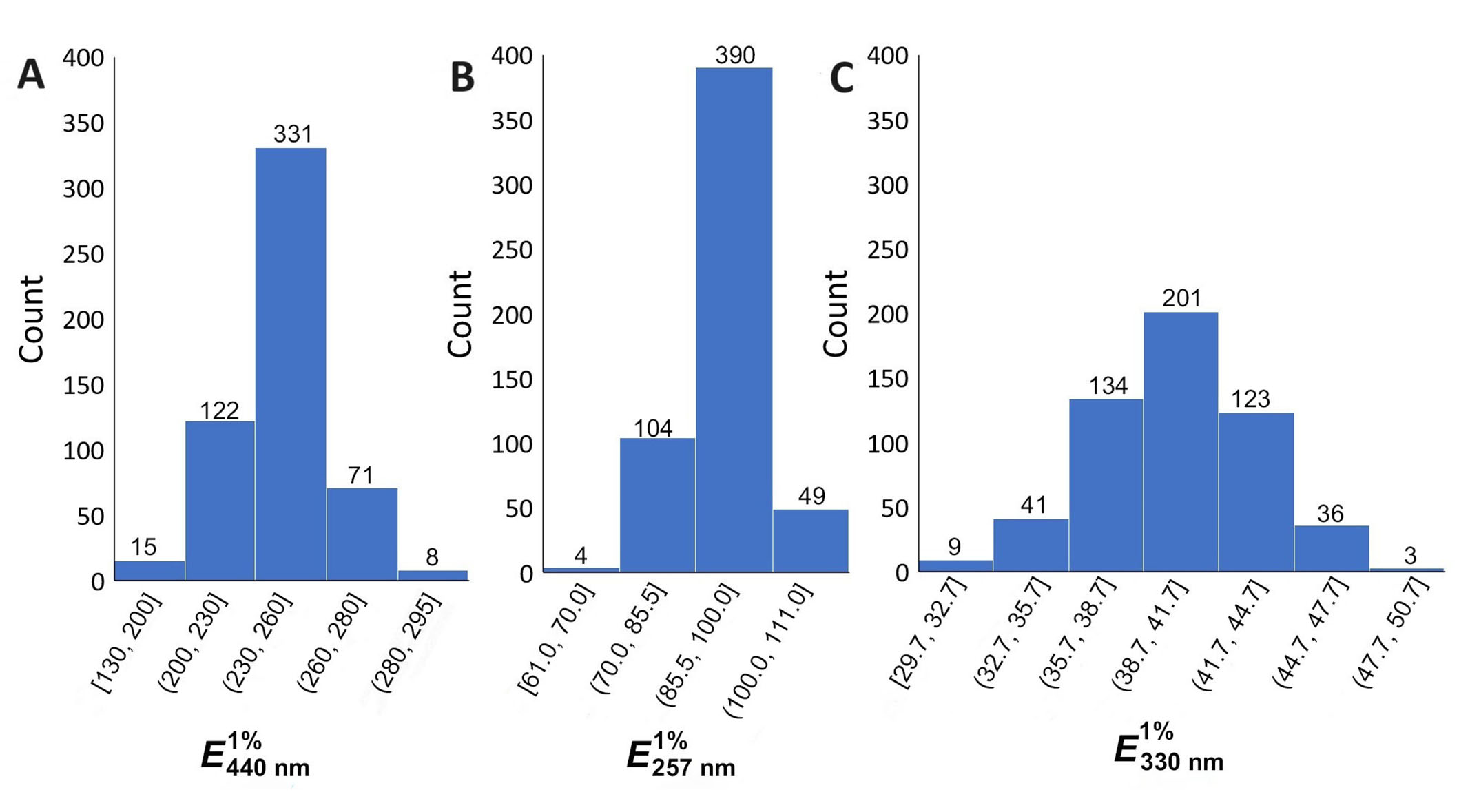
Frequency distribution histograms of
The
Changes in CS, FS, and AS values upon storage
A second round of analysis was performed for a subset of the 547 stored samples, nearly at the end of the first year after harvest. Sub-sampling was carried out considering: (a) the remaining amount of the stigmas; (b) the representativeness in annual produce; and (c) the initial CS values at the first round of analyses. Thus, we selected 66 samples (whole filaments) that represented nearly 40% of the 2022 production, evenly grouped according to initial CS values, e.g., 200−230 units, 230−250 units, 250−270 units, and > 270 units. The pattern of changes in CS of each stored sample at the end of the first year after its harvest and drying (November 2023) is shown in Figure 7.
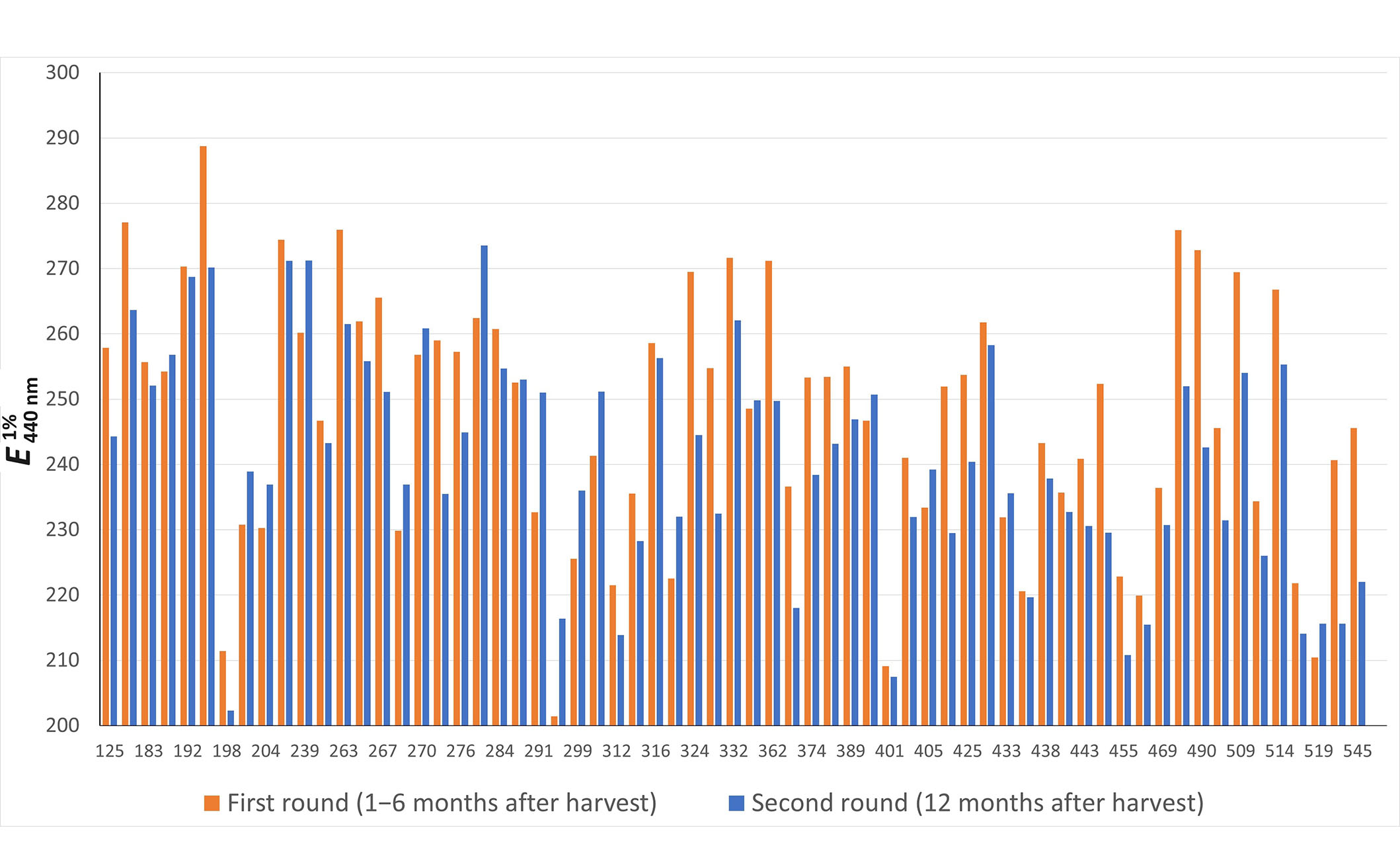
Changes in CS values of selected saffron samples (n = 66) that represent approximately 40% of the total 2022 production of Krokos Kozanis, at the end of the first year after harvest. Orange and blue bars correspond to average values from the first round (1 month to 6 months after harvest) and second round of analyses (12 months after harvest), respectively
Based on the CS values (Figure 7), the stored samples presented either a slight increase (4−7%) or decrease (10−11%) relative to the initial values but the changes did not exceed more than ±20 units on a dry weight basis. Despite the fluctuations, CS remained high so that all of the samples were still classified to ISO category I at the end of the first year after harvest. Special attention was paid to a sub-set of potentially extra quality Krokos Kozanis (CS = 230−260) because the majority (33 out of 38) of those samples retained the distinct premium quality characteristic. Moreover, all of the samples with very high initial CS (> 260) could be also classified in the “extra” quality commercial category.
A well-known pattern recognition method that entails PCA [19] of the data helped to get an insight into trends and explore patterns of variation in the compositional data of the 2022 saffron harvest in Kozani. Two principal components (PCs) were extracted from the data explaining 97.4% of the total variance. A closer look into the score and corresponding loading scatterplots of the samples showed a clear pattern of variation across the first PC primarily due to variance in the CS values [R2(X) = 93.3%] (see Figure S7A). Distinct differences in AS and FS [R2(X) = 4.1%] accounted for the sample distribution along the second PC (see Figure S7B and C). It is important to note that the PCA score scatterplot illustrates in a multivariable approach the data shown in Figures 6 and 7. Additionally, the representation of the scattered data reflects multiple sources of product variability in terms of organoleptic quality characteristics that may arise from different production, processing, and storage conditions per grower given the minimal genetic variability of Crocus sativus L. species [20].
Discussion
The total area of registered fields for the cultivation of Krokos Kozanis is considered small; it is comparable to that for the “Zafferano di Sardegna” in Italy but at least 20-fold smaller compared with the area registered for the cultivation of the “Azafrán de la Mancha” saffron in Spain on the basis of the respective documentation downloaded from the eAmbrosia database. This indicates the importance of homogeneity in agricultural and processing practices in order to reduce variability in the quality characteristics of the final product, the spice saffron that will bear the PDO trademark Krokos Kozanis.
Regarding the weather conditions in the Kozani region, especially the area around Krokos village, it is considered typical of the continental-Middle European climate, characterized by cold-wet winter and hot-dry summer. Based on the experience of local saffron growers, higher rainfall levels during the spring period (especially in May) favor the growth of the plant corm (beginning of the dormancy period). Similarly, increased rainfall in late August to September (stage of sprouting) and mid-October to mid-November (flowering stage) favors flowering of the crocus plant. Mild climatic parameters, like moderate temperatures (10°−20°C), low-intensity winds, and increased rainfall from early October to mid-November, are ideal conditions for its flowering. Cold winter period (start of leaf and replacement corm development stage) is also welcome. The meteorological data of the harvest year 2022 presented certain irregularities which, if continued, may have adverse effects on the production line and necessitate adaptation of the traditional agricultural practices to the new climatic trends. For example, the production yield must compensate for reduced precipitation with irrigation following broadcast prediction. However, excess precipitation in October is not possible to be addressed and the consequence may be detrimental for both the yield and the quality characteristics of the harvested pistils. The available data signify that the precipitation and the increase in mean annual temperature influence the annual growth cycle of the Crocus sativus L. crop in the Kozani region as in all areas of its cultivation [21–24].
All of the saffron samples from the 2022 harvest period in Kozani complied with the specification of ISO 3632-1:2011 regarding
Overall, there are two points of notice. First, it is highly probable that the annual production of Krokos Kozanis retained the highest ISO quality grade throughout the whole year after its harvest, given that special provisions are taken in the Cooperative installations. Second, a minimum CS value of 230–240 units is probably a valid threshold to tolerate metrological errors (RSD%) as well as variability of “extra” quality Krokos Kozanis within a one-year storage period. These patterns are well illustrated in a PCA score scatterplot (Figure S7) that helps to get an oversight of the variation according to ISO quality parameters.
It is important to emphasize that the results of this study outline the quality characteristics of the saffron products from every registered producer that was delivered to the Cooperative by its registered members. This is the first work that offers insight into individual annual produce. The systematic sampling design was essential to produce reliable data and build a comprehensive database that represents authentically saffron from a PDO-certified region. The collected data strongly support the view that nearly the whole quantity of saffron that was produced in the Kozani region during the 2022 harvest meets the technical requirements for the PDO Krokos Kozanis. As these specifications rely on the minimum ISO 3632-1 ones for quality category I and the latter are regularly revised to promote more stringent control in the global saffron market, it becomes necessary to assess fluctuations in the PDO technical specifications over the years and to regularly update them in the EU register. For example, the ISO standard criteria have changed since 1999, the date of the Krokos Kozanis registration as a PDO (1999). During that period, a relevant research project was carried out in the same Laboratory [9] using samples from 662 growers that were pooled according to the size of the annual produce they represented (between 0.1 kg/per and 21.9 kg/per grower). The test samples were examined according to ISO 3632-1:1993 version of standard specifications (minimum
The present work can be considered an important step for building up a compositional database for the PDO Krokos Kozanis that should be regularly updated in view of changing international trade standard requirements. The database may serve as a primer collective information resource not only for the internal QC management system of the Cooperative but also for the official controls of the registered product. The results of this study may be also useful for academia, interested stakeholders and producers. Moreover, in a period of unexpected meteorological phenomena that seem to stress the plant growth cycle and its discrete stages, the collected scientific evidence provides undisputed information for the need to advance rapidly the research efforts to ensure the sustainability of this sterile plant cultivation that survives since antiquity in areas like Iran, Middle East, Greece, Morocco, Italy, and Spain.
Abbreviations
| AS: | aroma strength |
| CS: | coloring strength |
| EU: | European Union |
| FS: | flavor strength |
| HNMS: | Hellenic National Meteorological Service |
| ISO: | International Standard Organization |
| PCA: | principal component analysis |
| PCs: | principal components |
| PDO: | Protected Designation of Origin |
| QC: | quality control |
| RSD: | relative standard deviation |
| UV-Vis: | ultraviolet-visible |
Supplementary materials
The supplementary material for this article is available at: https://www.explorationpub.com/uploads/Article/file/101036_sup_1.pdf.
Declarations
Acknowledgments
The authors thank Mr. Vassilios Mitsopoulos, President and Dr. Sofia Vartzoka, Quality Manager of the Cooperative of Saffron Growers in Kozani for fruitful discussions and suggestions, technical assistance, and access to information that helped to complement the database. The authors thank Mrs. Mirsini Chroni for technical assistance.
Author contributions
SAO: Conceptualization, Investigation, Writing—original draft, Writing—review & editing, Formal analysis, Data curation, Project coordination, Supervision. MZT: Conceptualization, Investigation, Writing—original draft, Writing—review & editing, Supervision. Both authors read and approved the submitted version.
Conflicts of interest
Both authors declare that they have no conflicts of interest. The data and results of this study are not affected by the interest of the Kozani Saffron Growers Cooperative.
Ethical approval
Not applicable as the subject of this article is not human research. Information on saffron growers in supplementary material was obtained pseudonymously. No personal data were presented. Only the demographic profile was presented as an element of the cultivation activity. The information collection and publication comply with the General Data Protection Regulation (GDPR).
Consent to participate
Informed consent to participate in the study was obtained from all participants.
Consent to publication
Not applicable.
Availability of data and materials
The raw data supporting the conclusions of this manuscript will be made available by the author (Stella A. Ordoudi, steord@chem.auth.gr), without undue reservation, to any qualified researcher.
Funding
The experimental data of this research are linked to the project “ISO 3632 Trade Standard Specifications & Quality Improvement of “Krokos Kozanis” product (ELKE/AUTH contract no 278709) financed by the Kozani Saffron Growers Cooperative. The funders participated in meta-data collection but had no role in study design, data analysis, decision to publish, or preparation of the manuscript.
Copyright
© The Author(s) 2024.
Publisher’s note
Open Exploration maintains a neutral stance regarding jurisdictional claims in published maps and institutional affiliations.
